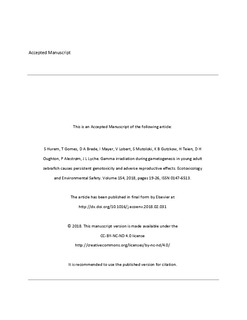Gamma irradiation during gametogenesis in young adult zebrafish causes persistent genotoxicity and adverse reproductive effects
Hurem, Selma; Gomes, Tania; Brede, Dag Anders; Mayer, Ian; Lobert, Viola; Mutoloki, Stephen; Gutzkow, Kristine Bjerve; Teien, Hans-Christian; Oughton, Deborah Helen; Alestrøm, Peter; Lyche, Jan Ludvig
Peer reviewed, Journal article
Accepted version
Permanent lenke
http://hdl.handle.net/11250/2602363Utgivelsesdato
2018Metadata
Vis full innførselSamlinger
- Artikler [5068]
- Publikasjoner fra CRIStin FHI [7550]
Originalversjon
Ecotoxicology and Environmental Safety. 2018, 154 19-26. 10.1016/j.ecoenv.2018.02.031Sammendrag
The biological effects of gamma radiation may exert damage beyond that of the individual through its deleterious effects on reproductive function. Impaired reproductive performance can result in reduced population size over consecutive generations. In a continued effort to investigate reproductive and heritable effects of ionizing radiation, we recently demonstrated adverse effects and genomic instability in progeny of parents exposed to gamma radiation. In the present study, genotoxicity and effects on the reproduction following subchronic exposure during a gametogenesis cycle to 60Co gamma radiation (27 days, 8.7 and 53 mGy/h, total doses 5.2 and 31 Gy) were investigated in the adult wild-type zebrafish (Danio rerio). A significant reduction in embryo production was observed one month after exposure in the 53 mGy/h exposure group compared to control and 8.7 mGy/h. One year later, embryo production was significantly lower in the 53 mGy/h group compared only to control, with observed sterility, accompanied by a regression of reproductive organs in 100% of the fish 1.5 years after exposure. Histopathological examinations revealed no significant changes in the testis in the 8.7 mGy/h group, while in 62.5% of females exposed to this dose rate the oogenesis was found to be only at the early previtellogenic stage. The DNA damage determined in whole blood, 1.5 years after irradiation, using a high throughput Comet assay, was significantly higher in the exposed groups (1.2 and 3-fold increase in 8.7 and 53 mGy/h females respectively; 3-fold and 2-fold increase in 8.7 and 53 mGy/h males respectively) compared to controls. A significantly higher number of micronuclei (4–5%) was found in erythrocytes of both the 8.7 and 53 mGy/h fish compared to controls. This study shows that gamma radiation at a dose rate of ≥ 8.7 mGy/h during gametogenesis causes adverse reproductive effects and persistent genotoxicity (DNA damage and increased micronuclei) in adult zebrafish. Gamma irradiation during gametogenesis in young adult zebrafish causes persistent genotoxicity and adverse reproductive effects
